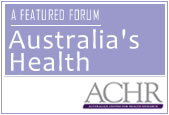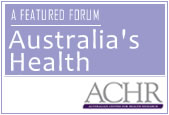Reforming Health: What Australian Healthcare might look like in 2015

This speech was presented by Andrew Podger on 30 November 2009 at the GAP/ACHR Congress on Australia’s Health.
Let me paint two scenarios, both positive, based on the Australian Government pursuing substantial elements of the National Health & Hospital Reform Commission’s NHRCC’s recommendations.
2015 is only five years away, so we should not expect revolutionary change by then. But I am hopeful that sufficient action will have been taken to confirm the future direction of the Australian health system.
I could of course be wrong.
I am sure the Commonwealth Department of Health will be advising the Rudd Government that there is much merit in the NHHRC’s proposed ‘Healthy Australia Accord’, but that some parts are too expensive or are not feasible in the timeframe.
Being the eternal optimist, I believe the following elements could be in place by 2015:
- A more comprehensive primary health system, funded by the Commonwealth.
- A better structured approach to aged care, sub-acute care and out-patient care, funded by the Commonwealth.
- A better managed public hospital system, with shared funding.
- Some modest expansion of dental healthcare.
- Some real advances in the IT field.
- A firmer long-term approach to funding Indigenous healthcare.
Let me expand on these elements.
On primary healthcare, I doubt we will see too many ‘super clinics’, but a better mix of privately operated general practices offering a wide range of ancillary services; there may be some salaried services both privately owned and publicly managed, particularly in rural and regional areas. I expect some innovation in funding arrangements but no dramatic move away from fee-for-service. The innovations may include more extensive agreements or even contracts, with more rewards for various population health outcomes and service access guarantees complementing fees-for-services.
These changes will increase the capacity of the health system to coordinate care for chronically ill and at-risk people including the mentally ill and frail aged by rewarding effectiveness of care as well as effort. Commonwealth funding will require the Commonwealth to develop much better regional planning processes in consultation with the States and Divisions of Primary Care.
On aged care, with full responsibility the Commonwealth can develop and implement a more comprehensive, articulated care assessment system, entitling people to a range of appropriate services which they can access wherever they live. Supply-side controls may be relaxed somewhat, but only with the strengthening of demand-side controls including accommodation bonds and fees for extra services, opening up opportunities for provider innovation and competition. This should also open up opportunities for closer links between hospital rehabilitation services, sub-acute care and long-term care assessment and care provision. Greater acceptance of and availability of palliative care should lead to more dignified and peaceful dying.
On acute care, a national purchaser-provider model should lock-in the successful Victorian model, which includes independent, professional hospital boards that employ CEOs with the capacity and responsibility to manage hospitals that are safe, provide quality care and operate efficiently in the interests of their patients. This is essential to address the politicisation and bureaucratisation of hospitals which we have seen in several States and Territories. Hopefully, this might also encourage more involvement by charities and churches in public hospital management and allow some competition between both public and private hospitals. Funding will be both activity-based and support capacity, particularly for hospitals with emergency departments that must handle substantial variations in workload, so that waiting times for both elective surgery and emergency departments can be better managed.
On dental health, I doubt the NHHRC model is feasible or affordable, particularly by 2015. There may be room for a more modest approach focussed on preventative care for children, services for chronically ill patients, and perhaps a more general safety net arrangement. But I cannot see how a ‘Medicare Select’ model could possibly be introduced for dental care ahead of other health care when there is no data at all in the dental field for risk-rated premiums to be calculated. And, as I say, I do not believe the NHHRC model would represent value-for-money even if it were feasible.
The next five years should see more tangible development of IT across the health system, with a new Medicare smartcard providing the main platform for integrating personal health records to support coordinated care. The direct funding by the Commonwealth of 40 percent of hospital activity costs should also be used to increase the capacity of Medicare
One of the reasons we have not got as far as we should on this agenda by now is that some people outside the health system keep suggesting an even more ambitious agenda, to link health administrative data to social security and tax data and so on. This is essentially an efficiency-only proposal that offers few tangible benefits to the public and major risks about privacy and big brother. It will always get defeated. But we can achieve real benefits for individuals and the community as a whole if we focus our attention on a health information agenda.
I am also hopeful that the Commonwealth will now commit itself to long-term increases in funding for Indigenous health commensurate with needs and the costs of service delivery. I am not entirely sure of the benefits of a new purchasing agency devoted to Indigenous health care, but certainly some moves in that direction could be taken by 2015. The Office for Aboriginal and Torres Strait Islander Health (OATSIH) should be strengthened considerably, and could extend its influence if Medicare
I am conscious that this scenario, while optimistic and drawing heavily on the NHHRC’s proposals, is still missing some elements I believe are essential if we are to address our key system-wide challenges:
- focusing on patients, rather than providers;
- achieving allocational efficiency; and
- clarifying the public/private balance to achieve both choice and equity, as well as greater efficiency.
Three additional measures could be taken by 2015 that might start to bridge the huge gap between this essentially interim NHHRC model and its preferred but as yet unproven ‘Medicare Select’.
a) The Commonwealth’s responsibility for all primary care requires a sensible regional planning framework: this would be greatly assisted if the AIHW was also asked to develop comprehensive regional health information reports that would help in the allocation of resources between regions and in the work of Divisions of Primary Care in monitoring health needs and total health spending;
b) Medicare Australia, or the Commonwealth Department, needs to establish a unit that can begin to calculate risk-rated premiums for different groups of Australians, not just based on age and sex, and to link this to professional medical knowledge of optimum health care regimes;
c) A trial should be conducted with some of the health funds of a replacement to the PHI rebate with a risk-rated premium in exchange for the funds accepting full responsibility for the health care of members who agree to participate in the trial.
Scenario Two: Not ‘Medicare Select’, but a Much Bigger Step Towards It.
I need to get this scenario off my chest. I remain very disappointed that the NHHRC dismissed my preferred model of moving much more quickly to a Commonwealth financial take-over. Its description of Option B in the Interim Report was far more bureaucratic than I ever intended, and its rejection of it seems to have entirely disregarded the necessity of its ‘Healthy Australia Accord’ proposal to strengthen regional planning and management of primary care by the Commonwealth. Moreover, I am still firmly of the view that it would be a better platform for testing the Scotton model of managed competition (or ‘Medicare Select’ as the NHHRC refer to it). I am most grateful that last week in Canberra Professor Tony Scott of the Melbourne Institute of Applied Economic and Social Research suggested Option B be resurrected, based upon the international evidence available.
The Prime Minister won enormous public support in 2007 when he said he would be willing to go to the people with a referendum seeking approval for a Commonwealth take-over in order to end the ‘blame game’. Unfortunately he linked this to the performance by the States in managing hospitals rather than to the underlying structural problems, making a take-over seem like a penalty rather than a sensible proposition that the States as well as the Commonwealth might support and help to make happen smoothly.
Why move more quickly? Firstly and most obviously to address the underlying issue of multiple funding exacerbating boundary problems and constraining a patient-oriented system, rather than addressing the symptoms we see in weak primary care, fragmented aged care, inefficient hospitals etc. But also because, if we only ever act incrementally we add to the risk of duplication and excessive bureaucracy: the Commonwealth will build up its capacity but will not transfer directly to it the expertise, for example, in Victoria in applying activity-based funding of hospitals, or the regional planning arrangements in several States. A bold step would be less costly, less bureaucratic and make best use of the expertise across the country.
A third reason is that the continued reliance on cooperation is a proven recipe for slowness and lowest common denominator decisions. It is not the way to get innovation and competition which some of those pining for States’ rights claim. Let me give just one example. It is now five years since I proposed to Mr Howard that the Commonwealth take full responsibility for non-hospital aged care, an area where the Commonwealth already bears over 90% of the costs. This would be a small but useful step towards rationalisation and better aged care. The Howard Cabinet agreed over four and a half years ago and took the idea to the Council of Australian Governments (COAG), which agreed in principle over three years ago. Mr Rudd on coming to power in 2007 confirmed his Government’s support as part of his broader human capital reform agenda and COAG has again agreed. But still it hasn’t happened. Who is resisting? Why are they still being given a hearing?
So, where could we get to by 2015 regarding my preferred scenario?
Mr Rudd could go to the people in the election next year, seeking their in-principle agreement. Apart from anything else, this would allow him to distance his Government from the NSW Government, including its extraordinary and continuing resistance to Victorian-style reform of its hospitals.
He could then set in train a three to five year project for a Commonwealth financial take-over:
- Identifying by mid 2011 a financial deal involving some renegotiation of the GST agreement in exchange for taking full financial responsibility;
- Establishing a dedicated, high-level project team to manage the take-over, with supporting committees based in each State and Territory;
- Setting a date – say, end 2013 – when State health officials will transfer to the Commonwealth;
- Allowing a further two to three years to rationalise bureaucracies, establish consistent purchasing policies for hospitals services, establish an overall regional planning framework and establish the central capacity for overall financial control.
While the dedicated project team would lead this overall restructure, day-to-day management would continue with minimum disruption to all those actually providing services. Many of the reforms in Scenario 1 would proceed, and may do so more quickly given the clear, national political leadership involved.
So, by 2015 we could have a single Commonwealth funder and purchaser, a framework which truly focussed on patients, and the capacity to address more firmly gaps and inequities. That framework would open up more opportunities to switch resources between primary, acute and sub-acute care etc according to patient needs and cost-effectiveness. The framework would also make it easier to develop a coherent approach to co-payments, and to test seriously the theoretically attractive but unproven benefits of managed competition.
Conclusion
As I said at the beginning, my two scenarios are both highly optimistic. They both require governments to take reform seriously, and to accept the risks of major change, where those whose interests are challenged will quickly get media attention while the longer term gains for the public will be harder to sell.
But the financial pressures the system will face will require hard choices. Putting off decisions, or taking only incremental steps or, worse, grandstanding without genuine action, is likely to make it harder, not easier, to switch resources to where they are needed and to achieve essential efficiencies and improved health.











foggy
February 12, 2010 at 8:39 am
switch resources